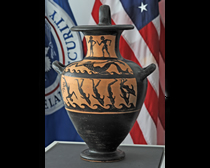The Law of Repatriation under “The Great Giveback”
 |
| Etruscan kalpis returned to Italy. ICE |
Few museums welcome judicial oversight, which is a rare occurrence. But it happened recently in a matter involving an illicit kalpis purchased in good faith by the Toledo Museum of Art (TMA). Reported delays slowing the resolution of that case prompted the intervention of federal prosecutors. The matter concluded last year with a federal court order from the northern district of Ohio compelling the TMA–with the museum’s assent–to forfeit the Etruscan jug to Italy. Both the museum’s lawyer and its new director agreed to “the seizure of the Kalpis by HSI [U.S. Homeland Security Investigations], the judicial forfeiture of the Kalpis pursuant to 19 U.S.C. § 1595a(c)(1), and the return of the Kalpis to the Italian Government following forfeiture to the United States,” according to the June 22, 2012 order. The court ordered the seizure and forfeiture of the kalpis from the TMA because the jug constituted stolen property unlawfully imported into the United States. This example offers a mild preview of Eakin’s sought after “legal ruling to give up the art,” which museums themselves should not hope for unless their trustees desire judicial supervision.
1) an export license from Italy’s Ministry of Culture does not exist for the Kalpis which was alleged to have been originally purchased in 1935 by a private Swiss collector after Italy’s cultural patrimony laws originally took effect in 1909,
2) a Polaroid photograph was discovered amongst the entire Becchina archive of documents, invoices and photographs seized during a search warrant in Basel, Switzerland on February 23, 2002,…4) the Polaroid photograph appears to show mud on the Kalpis itself along with dirt on the actual photograph which demonstrates that the Kalpis was photographed in a non-institutional setting long after 1935, its alleged original sale date to the private Swiss collector,
5) similar Polaroid photographs of the Kalpis were seized during a search warrant executed in Geneva, Switzerland on September 12, 1995 at the offices/warehouse of Giacomo Medici (“Medici”), a known Italian art smuggler, who was convicted and sentenced in December 2004 by the Tribunal of Rome for violating Italy’s law of criminal association with the intent to receive stolen archaeological artifacts illegally removed from Italy’s cultural patrimony,
6) Medici’s sentencing document states that the Kalpis was sold by Medici to Becchina,
7) Medici’s sentencing document directly contradicts the information contained in the provenance and invoice provided by Becchina to the Museum at the time of purchase on August 26, 1982, that the Kalpis was (a) purchased by a private Swiss collector in 1935 at an art market and (b) sold by Karl Haug (“Haug”), the alleged son and heir of the private Swiss collector, to the Becchinas in 1980,…9) Ursula Becchina provided evidence after her arrest establishing that Gianfranco Becchina collected artifacts illegally in Italy from diggers and from Medici and provided fake documentation to create a provenance for the artifacts including other vases from southern Italy,
10) Ursula Becchina also provided evidence after her arrest establishing that she and Becchina used fake documents to create false provenances for other illegally obtained artifacts attesting to Haug as owner, and
11) the Kalpis, despite its high quality and worth, did not appear in any scientific publication until 1981, one year before the Museum acquired it.
So was the TMA case one of needless restitution? Or could this case have been won in a hard-fought and expensive court battle? No. That is why “The Great Giveback” should reexamine its opinion about the legal issues surrounding the repatriation of stolen and smuggled cultural heritage.

